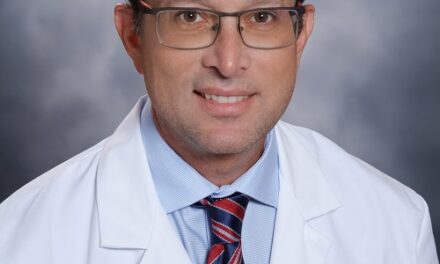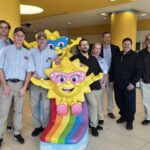For those familiar with Joey Fischer, the story is well known.
It was the mid-70s, and Fischer was well on his way to a successful career photographing record album covers for rock and roll bands, Elton John and Neal Diamond among them. (His record album cover for “Build Me Up Buttercup” by the Foundations would later earn a Grammy nomination in 1984.) Fischer spent many hours in the hospital visiting his father who had suffered a heart attack in 1977. “Laying in the ICU, he would tell me how many holes there were in a specific quadrant of the ceiling,” Fischer noted. “As a CPA, he counted the holes several times a day, ultimately to occupy his time and to keep his mind agile. We later learned that ICU Psychosis, essentially the absence of any stimulus, can be fatal, so my dad probably saved his own life by his hole counting.” During his many visits to the hospital, Fischer saw the light or, more exact, the lack of it.
“As soon as you passed through the doors of the lobby and into the inner core of the hospital, the physical environment deteriorated,” Fischer remarked. “Endless corridors leading to cold, clinical treatment and imaging departments with their high-tech, sterile, stainless steel environments could terrify the bravest souls.
“Patient-friendly design rarely reached into the actual rooms where treatment was delivered, or down to the dark, windowless basements where the radiation therapy department dwells. It’s really scary down there.”
Fischer realized that there was an entire industry of hospitals and clinics just waiting to have their interiors updated and uplifted with stress and anxiety-reducing nature imagery. In 1978, he launched a personal crusade to create patient-friendly healing environments when he founded the Art Research Institute (ARI). Headquartered in Atlanta and now boasting offices around the world, ARI provides facilities with Fischer’s outstanding nature photography, presented as backlit transparencies installed in the ceilings and walls, providing windows and skylights where neither is possible. “We call them ‘psychic escapes,’ whereby patients can imagine themselves out under a canopy of trees or on the beach, and away from the clinical and sterile environment of hospitals,” Fischer said.
During his many visits to the hospital, Fischer saw the light or, more exact, the lack of it.
“As soon as you passed through the doors of the lobby and into the inner core of the hospital, the physical environment deteriorated,” Fischer remarked. “Endless corridors leading to cold, clinical treatment and imaging departments with their high-tech, sterile, stainless steel environments could terrify the bravest souls.
“Patient-friendly design rarely reached into the actual rooms where treatment was delivered, or down to the dark, windowless basements where the radiation therapy department dwells. It’s really scary down there.”
Fischer realized that there was an entire industry of hospitals and clinics just waiting to have their interiors updated and uplifted with stress and anxiety-reducing nature imagery. In 1978, he launched a personal crusade to create patient-friendly healing environments when he founded the Art Research Institute (ARI). Headquartered in Atlanta and now boasting offices around the world, ARI provides facilities with Fischer’s outstanding nature photography, presented as backlit transparencies installed in the ceilings and walls, providing windows and skylights where neither is possible. “We call them ‘psychic escapes,’ whereby patients can imagine themselves out under a canopy of trees or on the beach, and away from the clinical and sterile environment of hospitals,” Fischer said.  ARI is a joint effort between Fischer and his wife, Janet, the former director of interior design at a VA hospital in Pittsburgh. She has more than two decades of experience as a healthcare interior designer, color consultant, and space planner.
“You can’t just throw a patient into a room and yell ‘heal,'” Fischer said. “Current research does confirm that viewing nature is an adjunct to the healing process, simultaneously reducing systolic blood pressure, while helping to redirect negative thought. Nature imagery sustains interest, decreases boredom; and provides for a beneficial passage of time.”
“A relaxed patient is more receptive, and consequently more responsive, to treatment,” Fischer noted.
Also, because images are patient focal points, viewing them before, during and after treatment, allows patients to relax more, squirm or fidget less, and thus help avoid costly repeat treatment.
Visual Therapy is Fischer’s generic name for his stress-reducing imagery. ARI offers custom ceiling and wall transparencies throughout the hospital. Transmitted light-or light that passes through color-casts an instant healing ambience and warming glow into any environment. But these are not just design additions. These are works of art, created by a gifted photographer.
The equipment manufacturers have taken notice of VisualTherapy and most all of them are funding Fischer’s imagery for clients who purchase their equipment.
“We’ve been empowering hospitals and physicians who are looking to purchase equipment to demand some sort of reward for spending millions of dollars,” said Fischer. “We call it a ‘value-added premium,’ essentially a donation of one percent of what the facility is spending for the equipment, to be set aside for VisualTherapy, and it has been a very successful program for all concerned.”
It’s a marketing tool for both the manufacturers and the hospitals, designed to improve and uplift patients’ experiences while in the facility.
ARI is a joint effort between Fischer and his wife, Janet, the former director of interior design at a VA hospital in Pittsburgh. She has more than two decades of experience as a healthcare interior designer, color consultant, and space planner.
“You can’t just throw a patient into a room and yell ‘heal,'” Fischer said. “Current research does confirm that viewing nature is an adjunct to the healing process, simultaneously reducing systolic blood pressure, while helping to redirect negative thought. Nature imagery sustains interest, decreases boredom; and provides for a beneficial passage of time.”
“A relaxed patient is more receptive, and consequently more responsive, to treatment,” Fischer noted.
Also, because images are patient focal points, viewing them before, during and after treatment, allows patients to relax more, squirm or fidget less, and thus help avoid costly repeat treatment.
Visual Therapy is Fischer’s generic name for his stress-reducing imagery. ARI offers custom ceiling and wall transparencies throughout the hospital. Transmitted light-or light that passes through color-casts an instant healing ambience and warming glow into any environment. But these are not just design additions. These are works of art, created by a gifted photographer.
The equipment manufacturers have taken notice of VisualTherapy and most all of them are funding Fischer’s imagery for clients who purchase their equipment.
“We’ve been empowering hospitals and physicians who are looking to purchase equipment to demand some sort of reward for spending millions of dollars,” said Fischer. “We call it a ‘value-added premium,’ essentially a donation of one percent of what the facility is spending for the equipment, to be set aside for VisualTherapy, and it has been a very successful program for all concerned.”
It’s a marketing tool for both the manufacturers and the hospitals, designed to improve and uplift patients’ experiences while in the facility.  Fischer’s imagery has been incorporated into more than 4,800 hospitals in 90 countries.
On contract with the Government Services Agency (GSA) for 30 years, Fischer’s Visual Therapy has been integrated into all 172 VA Medical Centers, and plethora of Department of Defense Air Force, Army, and Navy hospitals worldwide.
“Visual Therapy is a sign of caring that is instantly perceived and deeply appreciated by the patient as well as the caregivers, themselves,” Fischer said, adding that tranquil working environments contribute to increased staff satisfaction, and reduces employee turnover.
Fischer, 68, has been known for his pioneering work in hospitals for the past 32 years. He was honored in 1997 with a Smithsonian Award for his “contribution to the upliftment of humanity through Information Technology,” and his work inducted into the Archives of the Smithsonian Institution.
Just recently, Cooper Lighting Industries, one of the world’s largest lighting companies, has incorporated Fischer’s imagery in their many types of lighting fixtures in a program known as “Changing Views,” and Cooper will be bringing his imagery into the commercial, industrial, residential, design/architectural and institutional marketplaces.
“When you consider that the essence of life on our planet is light, it is truly an honor to be collaborating with Cooper,” remarked Fischer
True pioneers in their field, Joey and Janet have appeared on CNN, CBS This Morning, BBC, Voice of America, NHK/Tokyo, and feature stories on his work have been published in Newsweek, Fortune, Popular Science, McCalls, and many other foreign and domestic trade publications.
Still, despite his wide ranging success and the high quality of his work, Fischer takes a philosophical view. “I often tell people I hope they never get to see my work,” said Fischer, “because so much of it is in the radiotherapy environment, which is usually in the basement.”
Fischer’s imagery has been incorporated into more than 4,800 hospitals in 90 countries.
On contract with the Government Services Agency (GSA) for 30 years, Fischer’s Visual Therapy has been integrated into all 172 VA Medical Centers, and plethora of Department of Defense Air Force, Army, and Navy hospitals worldwide.
“Visual Therapy is a sign of caring that is instantly perceived and deeply appreciated by the patient as well as the caregivers, themselves,” Fischer said, adding that tranquil working environments contribute to increased staff satisfaction, and reduces employee turnover.
Fischer, 68, has been known for his pioneering work in hospitals for the past 32 years. He was honored in 1997 with a Smithsonian Award for his “contribution to the upliftment of humanity through Information Technology,” and his work inducted into the Archives of the Smithsonian Institution.
Just recently, Cooper Lighting Industries, one of the world’s largest lighting companies, has incorporated Fischer’s imagery in their many types of lighting fixtures in a program known as “Changing Views,” and Cooper will be bringing his imagery into the commercial, industrial, residential, design/architectural and institutional marketplaces.
“When you consider that the essence of life on our planet is light, it is truly an honor to be collaborating with Cooper,” remarked Fischer
True pioneers in their field, Joey and Janet have appeared on CNN, CBS This Morning, BBC, Voice of America, NHK/Tokyo, and feature stories on his work have been published in Newsweek, Fortune, Popular Science, McCalls, and many other foreign and domestic trade publications.
Still, despite his wide ranging success and the high quality of his work, Fischer takes a philosophical view. “I often tell people I hope they never get to see my work,” said Fischer, “because so much of it is in the radiotherapy environment, which is usually in the basement.”



























